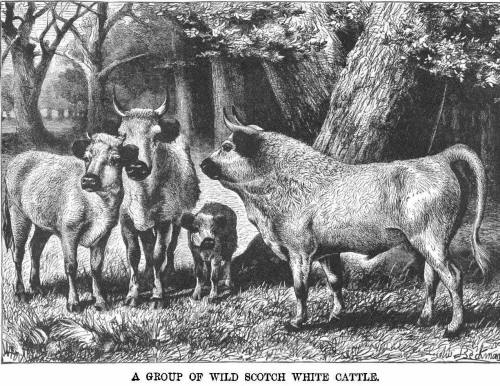|
IN some of the parks of
England and Scotland herds of white half-wild cattle are kept, which are
generally known as "wild cattle," and are direct descendants of the long
mained white cattle that formerly inhabited tbe Caledonian woods. At the
end of the last century these fine animals were still kept in the parks
of Chillingham in Northumberland, Wollaton in Nottinghamsbire, Giobume
in Yorkshire, Lime Hall in Cheshire, and Chartley in Staffordshire. The
oldest stock is at Hamilton, but in 1760 most of the animals had to be
killed on account of viciousness. Since then, however, great care bas
been taken in their breeding, and at present Chillingham Park has the
finest herd of these animals.
Another fine herd is at Hamilton, near Glasgow. Near Hamilton, on the
banks of the Avon, the ruins of the old Cadzew Castle are located, which
was destroyed during the reign of the unfortunate Mary. In the beautiful
park surrounding those ruins hundreds of enormous oaks grow, which are
the last remnants of the Caledonian woods, and are preserved with the
greatest care possible. The animals are kept in this park. They are
never stabled, the cows are never milked, and when tbe number of animals
increases too rapidly they are shot by huuters in the same manner as
deer and other game.
The animals are of a clear white color, the neck and tail tassel are
yellowish, the nose, eyes, ears, and hoofs are jet black, and the legs
from the knees downward are spotted. On some animals the ears are russet
red. The horns are very slender, and are whitish with black tips. They
are of medium length. The steers are very large and strong, and have
long. curly, shaggy tails, forming a mane. The annexed cut, which is
taken from the lliustrirte Zeitung, represents a steer, a cow, a heifer,
and a calf. The drawing was made by the well Known artist, Ludwig
Beckmann.
A GROUP OF WILD SCOTCH
WHITE CATTLE. © 1884
 |

